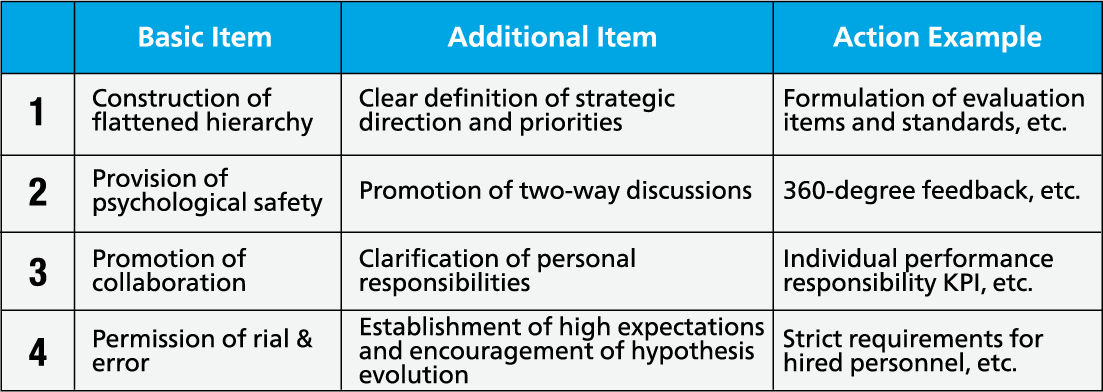As the purpose of DX promotion evolves into transformation of the existing business model, the need for corporate climate and culture transformation by the leadership team* is increasing. In particular, when considering transformation to a new business model through DX, the necessity to transform to a climate and culture that support the promotion of DX is recognized as a major issue.
ABeam DX Insight No.9 DX Leadership - Four Roles for Digital Culture Transformation -
- DX
- Management Strategy/Reformation

-
*
A group that consists of management committee members and is tasked with making DX-related decisions.
In particular, constructing a new business model is extremely difficult and, in the transformation of climate and culture for such a purpose, it is important to aim for "a climate and culture that allow initiatives in collaboration with various players and repeated trial and error while providing psychological safety on the basis of a flattened hierarchy." In addition, it is necessary to maintain a certain discipline in order to achieve results. In this respect, the leadership team plays a major role.
ABeam Consulting believes that, as roles to be played by the leadership team in climate and culture transformation to support company transformation through DX, the following are important.
 Figure1 Roles of Leadership Team in Climate and Culture Transformation for Construction of New Business Model
Figure1 Roles of Leadership Team in Climate and Culture Transformation for Construction of New Business Model
(1) Clearly define a strategic direction and priorities while maintaining a flattened hierarchy
When a company aims for autonomous operation by launching an agile organization, there is a risk that multiple teams will promote certain work simultaneously in parallel, dispersing their capabilities and increasing their freedom to an excessive extent. In such a situation, it is important for the leadership team to specify direction and priorities based on strategy, and it is necessary to define evaluation items and criteria for the initiative.
(2) Provide psychological stability while facilitating two-way discussions
While it is desirable to have lively discussions in an open atmosphere, in many cases remarks by influential members create the overall flow. Therefore, it is important to have a mechanism that enables constructive review comments even for influential remarks, and it is necessary to understand communication risks through 360-degree feedback, etc.
(3) Promote collaboration with other departments and external entities, and clearly define individual responsibilities
Collaboration is a necessary initiative that brings in various knowledge for creative consideration, but it also tends to obscure the responsibility of the creation of results. As a countermeasure, it is important to clarify the scope of individual responsibility for the delivery of digital transformation outcomes and, at the beginning of the initiative, necessary to clearly define the KPIs of performance responsibility for each individual.
(4) Allow trial and error while establishing high expectations and encouraging hypothesis evolution
While it is essential to have a proactive approach without fear of failure, excessive freedom is unacceptable. In consideration of an initiative high in both uncertainty and difficulty, mechanisms that encourage execution by highly capable talent as well as renewal and evolution without sticking to a single hypothesis are important, and stricter recruitment personnel requirements and evaluation item ingenuity are required.
Success factors in corporate transformation, not limited to DX, do not involve a retrofit-type climate and culture transformation, but rather a strategic climate and culture transformation in advance of strategic change. The leadership team plays a major role in the execution of transformation leveraged on climate and culture.
ABeam DX Insight
- ABeam DX Insight No.1 DX: Evolution to Second Stage
- ABeam Digital Transformation #1 DX: Giai đoạn 2 của Chuyển đổi Số
- ABeam DX Insight No.2 DX Vision & Scenario Formulation - What are the four prerequisite definitions of DX ? -
- ABeam Digitl Transformation #2 Tầm nhìn DX & Công thức nền tảng của DX - Bốn yếu tố tiên quyết của DX là gì? -
- ABeam DX Insight No.4 DX Vision & Scenario Formulation - From the viewpoint of next generation leader development -
- ABeam Digital Transformation #4 DX Vision & Scenario Formulation - Từ quan điểm của sự phát triển thế hệ lãnh đạo tiếp theo -
- ABeam DX Insight No.5 DX Vision & Scenario Formulation - What are the five benefits of "DX × Purpose Management"? -
- ABeam DX Insight No.6 DX Leadership - Four Missions & Seven Skills -
- ABeam DX Insight No.7 DX Leadership - Digital Understanding and Approach Required of Leaders -
- ABeam DX Insight No.8 DX Leadership - Five Elements for Successful Functioning of Digital Leadership Team -
- ABeam DX Insight No.9 DX Leadership - Four Roles for Digital Culture Transformation -
- ABeam DX Insight No.10 DX Talent - Three DX Talent Models -
- ABeam DX Insight No.11 DX Talent - DX Talent Requirements: Five Perspectives -
- ABeam DX Insight No.12 DX Talent - DX Talent Development: Three Success Factors and the Development System -
- ABeam DX Insight No.13 DX Talent - Solving Personnel Systems and Operational Issues in the Digital Age -
- ABeam DX Insight No.14 DX Engine - Defining the mission and role of the DX organization to rapidly accelerate DX -
- ABeam DX Insight No.15 DX Engine - The Three Elements of DX Human Resource Portfolio Management -
- ABeam DX Insight No.16 DX Engine - Trends and Measures for Data Driven Business Management -
- ABeam DX Insight No.17 DX Engine - Digital Governance: 4 Levers and Cycles -
- ABeam DX Insight No.18 DX Engine - Global Organizational Design & Workforce Management and DX: Four New Issues -
- ABeam DX Insight No.19 DX Engine - Eight Practical Points of Change Management -
- ABeam DX Insight No.20 DX Engine - Three Elements of Company Transformability -
- ABeam Digital Transformation #20 Động cơ DX- Ba yếu tố thuộc khả năng chuyển đổi của công ty -
Click here for inquiries and consultations

